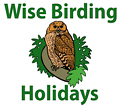
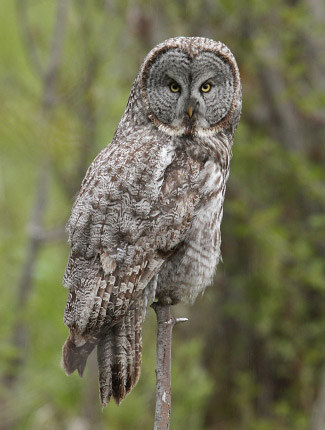
The impressive Great Grey Owl by Dubi Shapiro.
- The greatest diversity of owls in Europe, including Eagle, Great Grey, Ural, Tengmalm’s and Pygmy Owls, with Hawk and Snowy Owls also possible
- Some of Europe’s and the world’s other most spectacular localized birds including King and Steller’s Eiders, White-billed Diver, Gyr Falcon, Hazel Grouse, Brunnich's Guillemot, Siberian Jay, Red-flanked Bluetail and Pine Grosbeak
- Some of Europe’s and the world’s other most spectacular birds, notably White-tailed Eagle, Capercaillie, Common Crane and Bohemian Waxwing
- And breeding shorebirds such as Ruffs and Red-necked Phalaropes
- As well as a good chance of seeing Brown Bears from hides at night in almost 24-hour daylight
- And an outside chance of Wolf, Wolverine, Elk and Reindeer
- All in some of the wildest country in the region, from taiga forests to tundra inside the Arctic Circle
- Many bird species, notably owls, are either thinly spread across vast tracts of taiga and tundra or very localized, therefore it is essential to employ the services of local guides if you wish to see these species.
- It is possible to travel from Finland into Russia, via ferry from Belomorsk to the island of Solovetski on the White Sea coast where Belugas occur, especially off Cape Beluzi, or from Oulanka to Paanajarvi National Park where Brown Bears may be seen around Lake Paanajarvi.
- Between November and February during recent northern winters including 2017-2019 shoals of Herring have been congregating in the fjords and inlets of the Tromso region of northwestern Norway, north of the Arctic Circle, and these have been attracting Humpback and Killer Whales. There are daily boat trips out to look for them while the Tromso region is also a very good place to see the Aurora Borealis (Northern Lights). The sun does not rise above the horizon at this time of the year but twilight lasts for about 4 hours.
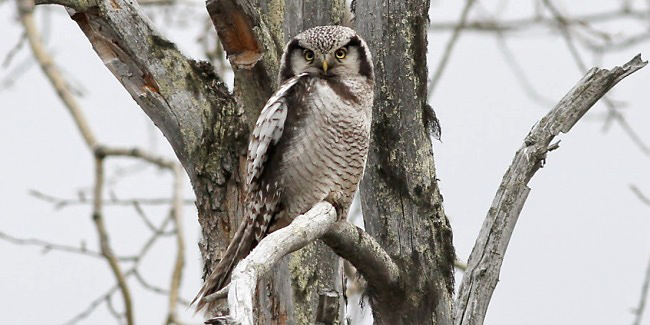
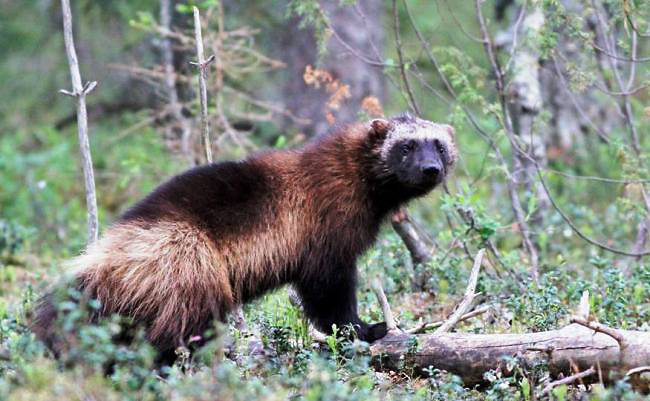
Hawk Owl and Wolverine, both in Finland, by Chris Townend.
Best Birds and other wildlife in Finland and Arctic Norway
Birds
(Eurasian) Eagle, Great Grey, Ural, (Northern) Hawk, Tengmalm’s (Boreal), (Eurasian) Pygmy
and Short-eared Owls, Common Crane, (Western) Capercaillie, Black, Hazel and Willow Grouse, Golden and White-tailed Eagles,
Gyr Falcon, White-billed Diver (Yellow-billed Loon), King and Steller’s Eiders, Terek Sandpiper, Red-necked Phalarope,
Long-tailed Skua (Jaeger), Brunnich’s Guillemot (Thick-billed Murre), (Atlantic) Puffin, (Bohemian) Waxwing, Red-flanked
Bluetail, Siberian Tit, Siberian Jay, Arctic Redpoll, Parrot Crossbill and Pine Grosbeak, as well as Black-throated and
Red-throated Divers (Loons), Red-necked Grebe, Whooper Swan, (Taiga) Bean Goose, Common Eider, Long-tailed Duck (Old Squaw),
Common and Velvet (White-winged) Scoters, (Rock) Ptarmigan, (Eurasian) Dotterel, Temminck’s Stint, Jack Snipe, Broad-billed,
Purple and Wood Sandpipers, Ruff, Spotted Redshank, Great Skua, Arctic Skua (Jaeger), Little Gull, Arctic Tern, Common
Guillemot (Murre), Black Guillemot, Razorbill, Black and (Eurasian) Three-toed Woodpeckers, Red-throated Pipit,
(White-throated) Dipper, Thrush Nightingale, (Red-spotted) Bluethroat, Fieldfare, Redwing, Blyth’s Reed, River, Marsh,
Icterine and Greenish Warblers, Pied Flycatcher, Brambling, Twite, Mealy Redpoll, (Red) Crossbill, Common Rosefinch, and
Lapland, Little, Rustic and Snow Buntings. Also a chance of Rough-legged Buzzard (Hawk), Snowy and Long-eared Owls, Shore
(Horned) Lark and Two-barred (White-winged) Crossbill.
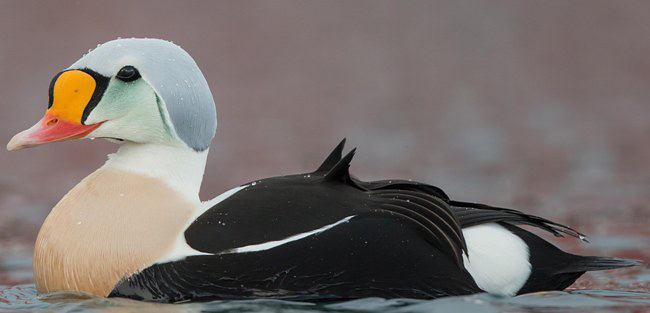
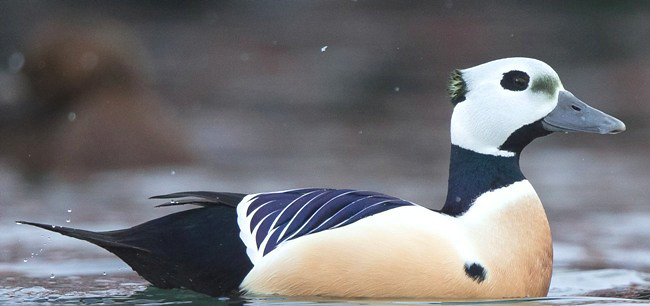
King and Steller's Eiders photographed by Simon Colenutt from the floating hide in Batsfjord port, Varanger, Norway.
Mammals
Brown Bear, Elk (Moose), Reindeer, Muskrat, Red Squirrel, Roe Deer, Brown and Mountain
(Arctic) Hares, and Grey Seal. Also a chance of Wolf, Wolverine, (Eurasian) Beaver, Siberian Flying Squirrel and (Saimaa)
Ringed Seal (in Linnansaari National Park).
Best Sites for Birds and other wildlife in Finland and Arctic Norway
- Finland
- Helsinki Area Thrush Nightingale, and Blyth's Reed and River Warblers.
- Oulu Area up to 8 owl species; Eagle, Great Grey, Ural, Tengmalm’s, Pygmy and Short-eared are regular but Hawk and Long-eared are occasional. Also Ruff (at leks viewable from observation towers at Liminganlahti) and a chance of Terek Sandpiper.
- Kuusamo Red-flanked Bluetail, Capercaillie (lek), Black (lek), Hazel and Willow Grouse, Siberian Jay, Siberian Tit and Little Bunting. Also a chance of Pine Grosbeak, Parrot Crossbill and Rustic Bunting.
- Martinselkosen Wildlife Centre A good chance of Brown Bears from hides. Also a chance of White-tailed Eagle.
- Wild Brown Bear Centre, Kuhmo A good chance of Brown Bears and Wolverines from four observation hides and 22 photography hides. Also a chance of Great Grey, Pygmy, Tengmalm's and Ural Owls during the autumn.
- Boreal Wildlife Centre, Kuhmo A good chance of Brown Bears from hides (fewer than Martinselkonen). Also a chance of Wolf (especially June-July), Wolverine and Golden Eagle.
- Era-Eero Lodge, Kontiovaara, near Lieska A chance of Brown Bear, Wolf (especially June-July) and Wolverine (especially late June to mid-July) from hides.
- Ivalo Jack Snipe, Broad-billed Sandpiper, Siberian Tit and Siberian Jay.
- Kaamanen Area A chance of Pine Grosbeak, Siberian Tit, Siberian Jay, Arctic Redpoll and Red Squirrel (at roadside cafe feeders).
- Norway
- Pasvik Valley Three-toed Woodpecker, Siberian Jay, Siberian Tit and Pine Grosbeak, the last three especially at feeders at BIRK Husky Guesthouse near Melkefoss on the border with Russia (along with redpolls).
- A6 Hawk Owl, south of E6/E75 junction.
- Varanger King and Steller’s Eiders, White-billed Diver, White-tailed Eagle, Gyr Falcon, Dotterel, Ruff, Red-necked Phalarope, Long-tailed Skua, Brunnich’s Guillemot, Puffin, Temminck’s Stint, Red-throated Pipit, Bluethroat, Twite, Arctic Redpoll, and Lapland and Snow Buntings. Also a chance of Snowy Owl.
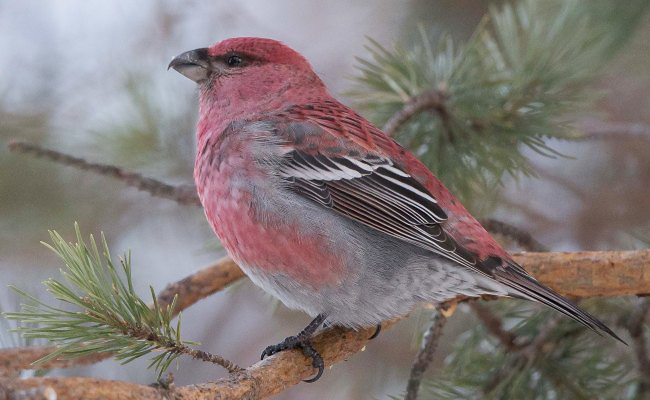
A fine male Pine Grosbeak photographed in the Pasvik Valley, Norway, by Simon Colenutt.
Best Times for Birds and other wildlife in Finland and Arctic Norway
Bears usually emerge from hibernation from mid-April onwards and those that visit the feeding stations where the hides are may head there first, for an easy meal, since they are hungry! Numbers then build up to early June when there is usually a fall in numbers during the rutting season when eating is not a priority. The bears return in July, usually until mid-August, and peak numbers usually visit the feeding stations around mid-July. By late July it can become too dark in the middle of the night to see and photograph the bears, although they may be around for several hours before the middle of the night. June-July is the peak time to see Wolves and Wolverine (especially late June to mid-July).
Fortunately the best time for bears in spring coincides with a good time to look for most owls which are easiest to locate in March-April when they are calling and easiest to see, with the help of the local guides who have located their nests during the early spring, in May-June (Beware! Some owls are very aggressive in defense of occupied nests, notably Ural). However, the first half of June, when bears become more elusive, is the best time to look for the widest range of birds, since some summer visitors don't usually arrive until early in the month. Early June is also before the main mosquito season which usually lasts from mid-June to early August, with peak numbers from late June to mid-July.
During the northern winter there may be as many as 15,000 Steller’s Eiders and 5000 King Eiders around Varanger in Arctic Norway with some usually remaining into spring, but only a few, mainly Steller’s, remain until June. White-billed Diver is also mainly a winter visitor to the Varanger area although a few usually remain through the spring and summer.
Recommended Bird Books etc. for Finland and Arctic Norway
A Complete Guide to Arctic Wildlife by R Sale. Helm, 2006.
Collins Bird Guide by L Svensson et al. Collins, 2010 (Second Edition).
Birds of Europe by L Jonsson. Helm, 1999.
Finding Birds in South Finland by D Gosney. Easybirder, 2010 (book and/or DVD).
Finding Birds in Lapland by D Gosney. Easybirder, 2010 (book and/or DVD).
Mammals of Europe, North Africa and the Middle East by S Aulagnier et al. Helm, 2009.
Mammals of Britain and Europe by D McDonald and P Barrett. Collins, 2005.
Collins Butterfly Guide by T Tolman and R Lewington. Collins, 2009.
Butterflies of Britain and Europe: A Photographic Guide by H Aarnio et al. A & C Black Publishers, 2009.
Apps etc.
Collins Bird Guide.
Where to watch birds in Europe & Russia by N Wheatley. Helm, 2000.
Don’t know which country/countries/regions to visit in Europe? Then it may be worth considering taking a look at this book, written by this website’s author. It is many years old of course but it still provides a starting point, an overview and a guiding light to the best birds and the best places to look for them in the region, and could save hours of searching for similar information on the internet. However, it is important to check more up-to-date sources for sites which have been opened up, sites and species which have been discovered, lodges that have been built etc. since the book was published.
Birding and Wildlife Trip Reports for Finland and Arctic Norway
Many trip reports, some for Finland and Arctic Norway, are posted on the websites listed here. On some of these websites some reports are independent and some are posted by tour companies who organize tours to Finland and Arctic Norway. These tour companies and others also post their own reports on their websites, which are listed under 'Some Organized Tours to Finland and Arctic Norway' below.
- The best website for trip reports is CloudBirders
- but these are also worth a look
- Birdtours
- Fatbirder
- Jon Hornbuckle
- Mammal Watching
Local bird and wildlife guides in Finland and Arctic Norway
The costs of organized tours partly reflect the quality of the tour leaders. Some leaders are certainly better than others and many companies claim their leaders are the best but even the best rely at least to some extent on the exceptional skills of the local guides they employ. If you are travelling independently, employing such local guides will greatly increase your chances of seeing the wildlife you wish to see.
Accommodation for birders in Finland and Arctic Norway
Some Organized Tours for birds and other wildlife to Finland and Arctic Norway
There are many tour companies who organize tours to see mammals, birds, other wildlife and other natural wonders. The cost of these tours vary considerably according to such variables as the airlines used, the number of days the tours last, the number of sites visited, the number of people in the group (an important consideration if you wish to see such wildlife as rainforest mammals and birds), the number of tour leaders, the standard of accommodation and transport, and the percentage profit the company hopes to make. Generally, where the number of days tours last and the number of sites visited are similar, the cheapest tours are those that use the cheapest airlines, accommodation and local transport, that have the largest groups with the least number of leaders, and that make the least amount of profit. The most expensive tours tend to be those which are exceptionally long, use the most expensive accommodation (ridiculously lavish in some cases, even for single nights) and which make the most profit. Some tour costs partly reflect the quality of the tour leaders. Some leaders are certainly better than others and many companies claim their leaders are the best but even the best rely at least to some extent on the exceptional skills of the local guides they employ.
While tour companies organize tours with set itineraries many also organize custom tours for individuals and private groups who instead of taking a tour with a set itinerary want to follow their own itinerary to suit their own personal tastes, whether it be mammals, birds, other wildlife, other natural wonders or even man-made attractions, or a mixture of them all. Many organized tours with set itineraries are also fast-paced and target as many species as possible, whether they are mammals, birds or other wildlife or everything, which usually leaves little time to enjoy the best sites and individual species, but on a custom tour those taking part can specify the pace and the sites and species they wish to concentrate on. Custom tours also suit people who like to travel with people they already know, rather than with a group of strangers, and they are popular with people with partners with different interests. Individuals, partners and small groups will almost certainly have to pay more for a custom tour than an organized tour with a set itinerary but a large group of friends may be able to travel for less than the price quoted for a set tour.
Tour companies who run organized tours to Finland and Arctic Norway include the following. Many of these also offer custom tours.
- Birdfinders
- Europe's Big 5
- Naturetrek
- New Horizons
- Wise Birding Holidays
- We are a small wildlife watching holiday company based in Devon (UK) specialising in birdwatching and mammal watching holidays across the world. What sets us apart from other wildlife watching companies is quite simple:
- 1 – small group sizes: (average between 4 – 8 people)
- 2 – a commitment to conservation: (donation after each tour)

